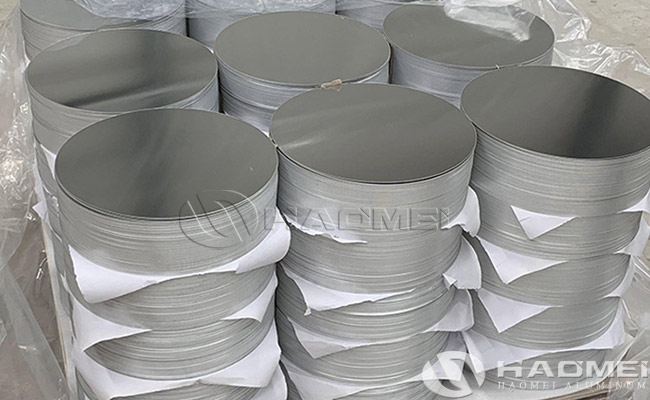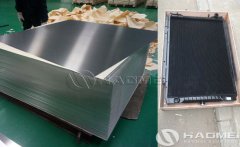-
- News Center
- Related News
-
- Home > News > Industry news >
- Deep Drawing Aluminium Circle
Deep drawing aluminium circle features high stamping elongation and excellent strength. It also offers excellent stamping properties, surface quality and mechanical properties. From melting and casting to hot rolling, cold rolling, and finishing, each process is rigorously controlled, with emphasis on thickness, plate shape, surface finish, and mechanical properties, ensuring the aluminum circle possesses optimal strength and formability. The deep drawn aluminium circle product is not only lightweight, durable, economical and environmentally friendly, but also exhibits excellent deep drawing properties and tensile strength, with an elongation of up to 20%.

Core Alloys of Deep Drawing Aluminium Circle:
- 1050/1100 pure aluminum:
Contains ≥99.5% aluminum and offers excellent plasticity (elongation 25%-30%), making it suitable for low-strength deep-drawing applications such as kitchenware and packaging.
- 3003 aluminum alloy:
Contains 1.0%-1.5% Mn and offers medium strength and corrosion resistance (elongation 37%-45%), making it a preferred choice for power battery casings and pressure cookers.
- 5052/5054 aluminum alloy:
Contains 2.2%-3.6% Mg and offers higher strength than the previous two alloys, making it suitable for deep-drawn parts requiring deformation resistance, such as automotive interiors and electronic housings.
Key Specifications of Deep Drawing Aluminum Circle:
Thickness: Conventional 0.2-6.0mm, hot-rolled special versions up to 10mm;
Diameter: Conventional 20-1200mm, sawn special versions up to 3500mm;
Temper: Mainly O (high plasticity, suitable for complex deep drawing), H12/H14 (medium strength, suitable for rigid parts), and H32 (for multi-pass deep drawing).
Excellent Processability and High Forming Quality of Deep Drawing Aluminum Circle:
- Excellent Deep Drawing Performance
Aluminum circles are produced from hot-rolled aluminum coils, resulting in uniform grain size and high elongation, capable of withstanding large deformations without cracking. For example, 1060 pure aluminum circles can achieve a deep drawing ratio of 1.6-1.8. The addition of manganese to 3003 aluminum alloy circles increases strength while maintaining good plasticity, making them suitable for forming complex shapes.
- Stable Surface Quality
The automated continuous stamping process eliminates scratches and oil stains caused by manual operation, achieving a surface finish of Ra 0.8μm or higher. After anodizing, the product exhibits no color variation, meeting the stringent appearance requirements of high-end cookware (such as non-stick pans and pressure cookers).
- Controllable Dimensional Accuracy
Dimensional accuracy reaches ±0.05mm, and thickness deviation is controlled within ±0.02mm, ensuring consistent assembly of parts such as lampshades and capacitor housings.
Comprehensive Performance of Deep Drawing Aluminium Circle
- Enhanced Corrosion Resistance
After anodizing, the salt spray test duration of 3003 aluminum alloy circles is extended from 48 hours to over 1,000 hours, making them suitable for marine lighting housings.
- Heat Dissipation and Lightweighting
The aluminum circles have a thermal conductivity of 237 W/(m·K), three times that of steel. When used in rice cooker inner pots, thermal efficiency is increased by 25% while weight is reduced by 40%, aligning with the trend of lightweight home appliances.
- Environmental Compliance
The product complies with RoHS and REACH standards, with levels of hazardous substances such as lead and mercury below the limit. It is 100% recyclable, meeting market access requirements in the EU and other countries.
Widely Application Scenarios of Deep Drawing Aluminium Circle:
- Cookware
Pressure cookers and smokeless pots utilize 0.6-2.0mm thick aluminium circles. After deep drawing, the pot wall thickness uniformity is ±0.03mm, improving thermal conductivity by 30% and enhancing cooking efficiency.
- Lighting
Lampshades utilize 0.3-1.0mm thick aluminum circles. After spin forming, the surface roughness reaches Ra 0.4μm, with a reflectivity of 92%, saving 40% energy compared to plastic lampshades.
- Electronic Appliances
Capacitor housings utilize 0.5mm thick 3003 aluminium circles. After deep drawing, the housing thickness tolerance is ±0.01mm, ensuring accurate assembly of internal components and reducing failure rates by 50%.
- Emerging Industries
Power battery housings utilize 1.5mm thick aluminum circles. A deep drawing ratio of 1.5 results in crack-free operation. Combined with laser welding, the airtightness reaches 0.02cc/min, meeting safety standards for new energy vehicles.
Through material optimization and process upgrades, deep drawing aluminium circles have achieved comprehensive improvements in processing efficiency, product quality, and application scope. Their core value lies in producing higher-performance, more environmentally friendly products at a lower cost, maintaining competitiveness in traditional sectors such as kitchenware, lighting, and electronics while expanding into high-end markets such as new energy and aerospace. For manufacturers, choosing these aluminum circles can significantly reduce overall costs (by approximately 15%-20%) and increase product added value (e.g., a 30%+ premium for high-end kitchenware), making them a key choice for material upgrading and industrial transformation.
- Haomei aluminum
- haomei Aluminium Plate





